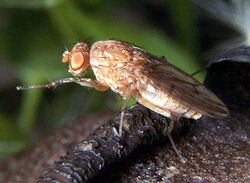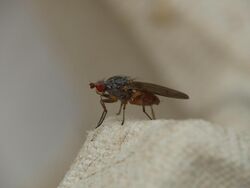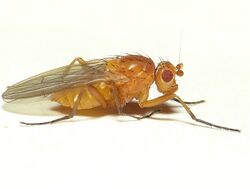Biology:Heleomyzidae
| Heleomyzidae | |
|---|---|

| |
| Suillia sp. | |
| Scientific classification | |
| Domain: | Eukaryota |
| Kingdom: | Animalia |
| Phylum: | Arthropoda |
| Class: | Insecta |
| Order: | Diptera |
| Section: | Schizophora |
| Subsection: | Acalyptratae |
| Superfamily: | Sphaeroceroidea |
| Family: | Heleomyzidae Westwood, 1840 |
| Subfamilies | |
| |
| Diversity | |
| At least 80 genera | |
File:Suillia spec - on fungus.ogv
The Heleomyzidae is a small family of true flies in the insect order Diptera. Over 740 described species of Heleomyzidae occur in about 76 general[1] distributed throughout the world.
Description
Heleomyzids are small to medium-sized flies which vary in colour from yellow to reddish yellow or reddish brown to black. The wings often have small but distinctly longer, well-spaced spines mixed with the shorter spines along the leading edge and the crossveins are often clouded.
Taxonomy
Over 740 described species of Heleomyzidae occur in about 76 genera[1] and 22 tribes distributed throughout the world; the greatest number occur in the Holarctic region. Around 100 species of Heleomyzidae are found in North America. Most of the subfamilies have been commonly recognized as families in the past, but are now included within the Heleomyzidae.[2] The composition and monophyly of the family continues to be controversial. McAlpine[3] recently combined Heleomyzidae and Sphaeroceridae into Heteromyzidae, but this arrangement has not been widely accepted.
Ecology
Adults of Borboroides and Heleomicra are attracted to carcasses and faeces. Larvae feed on decaying plant and animal matter, mushrooms, and various fungi. The larvae of the Holarctic Suilliinae and Tapeigaster occur principally in fungi. Larvae of Cairnsimyia live in borer tunnels in trees.
References
- ↑ 1.0 1.1 Pape, Thomas, Vladimir Blagoderov, and Michail B. Mostovski. "Order Diptera Linnaeus, 1758." Animal Biodiversity. Magnolia Press, 2011.
- ↑ McAlpine, David K. "The Australian genera of Heleomyzidae (Diptera: Schizophora) and a reclassification of the family into tribes." Records of the Australian Museum 36.5 (1985): 203-251.
- ↑ McAlpine, David K. "Review of the Borboroidini or Wombat Flies (Diptera: Heteromyzidae), with reconsider-ation of the status of families Heleomyzidae and Sphaeroceridae, and descriptions of femoral gland-baskets." RECORDS-AUSTRALIAN MUSEUM 59.2/3 (2007): 143
External links
Identification resources
Palaearctic
- Czerny, L., 1924. Monographie der Helomyziden. Abhandlung der Zoologischen-Botanischen Gesellschaft in Wien, 15(1): 1–166. Keys genera and species.
- Czerny, L., 1937. Ergänzungen zu meiner Monographie der Helomyziden. X. Konowia, 16(2): 137–142.
- Gorodkov, K.B., 1984. Family Heleomyzidae (Helomyzidae), 15–45.In: Soós Á. and L. Papp, (eds.), Catalogue of Palaearctic Diptera, vol.10, Budapest.
- Papp, T.,1978. Some cavernicolous Diptera of the Geneva Museum. Revue Suisse de Zoologie 85: 99–106.
- Papp, T., 1998. Heleomyzidae. Chapter 3.41, 439–455. In: Papp L. and B. Darvas, (eds.), Contribution to a manual of Palaearctic Diptera. Vol. 3. 1998. Science Herald, Budapest, 880 pp.
United Kingdom
- Collin, J.E. 1943b. The British species of Helomyzidae (Diptera). Entomologist's Monthly Magazine 79: 234–251.
Nearctic
- Gill, G.D., 1962. The Heleomyzid flies of America north of Mexico(Diptera: Heleomyzidae). Proceedings of the U.S. National Museum, 113(3465): 495–603. Keys genera and species.
- Gill, G.D and B.V. Peterson, 1987.1989. Heleomyzidae, 973–980. In:McAlpine J. F., (ed.), Manual of Nearctic Diptera Vol. 2, Research Branch Agric. Canada, Monograph no. 28, IV + 675–1332. Keys genera and species.
Australasia
- McAlpine, D.K., 1985. The Australian genera of Heleomyzidae (Diptera: Schizophora) and a reclassification of the family into tribes. Records of the Australian Museum, 36: 203–251.
Taxonomic lists
- World list
- The European subfamilies, tribes, genera and species - Fauna Europaea
- West Palaearctic including Russia
- Nearctic
- Australasian/Oceania
- Japan
Wikidata ☰ Q2233992 entry
 |



